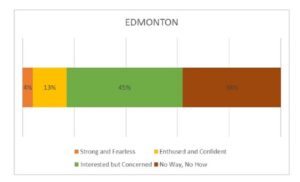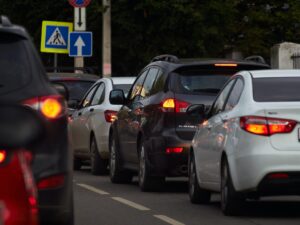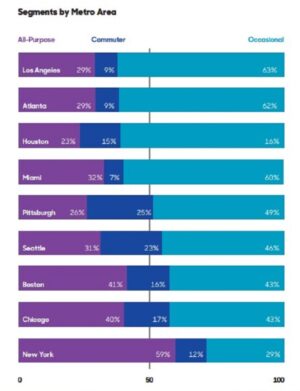“It is not the strongest or the most intelligent who will survive
but those who can best manage change.” -Charles Darwin
Winnipeg is a city that is nearing a population of one million people. We are also a city with an 80% driving mode share. Most of those trips are made with one person in the vehicle.
If these factoids don’t worry you, they should.
Whether you care about health, the environment, or the financial stability of your city, you should care deeply about how its residents are getting around. A city where the vast majority of trips, even those within a comfortable walk/bike/bus distance, are made in a personal vehicle is a city that will struggle. Whether it’s the high maintenance and replacement costs, the increased injuries and deaths from crashes, the GHG burden or the lack of connection for everyone outside of a personal vehicle, car-oriented cities are not pointing to prosperity.
But, time and again, when presented with opportunities to make it easier to walk/bike/bus, our city will falter. Whether it’s narrowing driving lanes, losing a few parking spaces or slowing down speeds, many projects face delay, cancellation or just the chipping away of policies until little remains of benefit.
What we hear from a variety of cities, businesses and residents, time and again, is the fear of change. The fear that anything that would make it less convenient to drive will lead to shuttered businesses and residents unable to complete their daily tasks.
Overall, there seems to be a fear from elected officials that Winnipegers just don’t want this change.
And, I get it. We are one of thousands of cities across North America who jumped fully into the Suburban Experiment over 70 years ago. We are now several generations into this experiment. Not that long ago, each household had a family car. Today, I’m going to bet that most of your families, or families you know, have a vehicle for every person of driving age in the household.
Perhaps vehicles are no longer instruments of freedom, but prosthetic tools that are required to live our day to day lives? (Jeff Speck).
What if we don’t have to CONVINCE people?
As part of my work in sustainable transportation, I’ve had the chance to learn a lot about behaviour change. Much of my job involves assisting workplaces with TDM programs (transportation demand management). From this work I’ve had the opportunity to see the results of countless surveys around transportation. One glaring trend: a vast majority of folks are driving alone each day. But when asked if that’s their “ideal” way to get there, driving alone falls sharply, while transit, carpooling, biking and walking rise. And of course, in the open comment section we get the stories of woe:
“I would love to bus, but [the bus is too full/doesn’t arrive on time/transfers take too long] and I have no choice but to drive.”
“I would love to bike, but it’s scary biking on the road, so I have no choice but to drive.”
“I would love to carpool, but I have to drive my kids to school and then from school to their activities. I have no choice but to drive.”
No choice. Over and over and over.
And while municipal governments can’t necessarily control the daycare travesty in our city (although zoning policies could help), they sure can do an awful lot about the transit and biking realities people are facing each day for every trip.
“The traffic … before/after school is awful. I am afraid to allow my child to bike to school because this traffic is extreme.” – School Travel Survey, City of Winnipeg, Fall 2020

Types of Cyclists
Back in 2009, Roger Geller published his findings on the “four types of cyclists” from his work in the Portland Office of Transportation. Understanding how people behave in different levels of stress is important for cities identifying how to encourage more trips by bike. The four types are:
- Strong and Fearless: People willing to bicycle with limited or no bicycle-specific infrastructure. Aka: “road warrior.”
- Enthused and Confident: People willing to bicycle if some bicycle-specific infrastructure is in place
- Interested but Concerned: People willing to bicycle if high-quality bicycle infrastructure is in place
- No Way, No How: People unwilling to bicycle even if high-quality bicycle infrastructure is in place
How many people fall into each group?
“Jennifer Dill, Ph.D., at Portland State University, led a survey of adults in the 50 largest metro regions in the U.S. to verify Geller’s theory that roughly 1% of adults identified as “Strong and Fearless”, 7% identified as “Enthused and Confident”, the majority — 60% — identified as “Interested but Concerned”, and the rest — 33% — identified as “No Way, No How”. Dill found that theorized breakdown was remarkably close, with slightly more people identifying as “Strong and Fearless” (7%) and as No Way, No How (37%).” (Understanding the “four types of cyclists”, Alta).
Now, I know what you’re thinking. This is WINNIPEG where we have WINTER this DOES NOT APPLY. Let’s remember that weather doesn’t influence the number of riders in a city. Infrastructure does (please watch Why Canadians Can’t Bike In the Winter (but Finnish people can).
But, to be fair (and since the City of Winnipeg hasn’t done this research that I know of), let’s use the numbers from Edmonton, Alberta. In Edmonton, they found:
- Strong and Fearless, 4%
- Enthused and Confident, 13%
- Interested but Concerned, 45%
- No Way, No How, 38%

Even if we go more conservative for Winnipeg, say 40% in the No Way, No How category and just 43% in Interested but concerned, that is A LOT of people that would ride for some or all of their trips if the journey was not so hostile.

And, according to our numbers, we have around 20% of Winnipeggers travelling by bike for some or all of their trips currently, which is well above the 17% that we should have based on our lack of a complete, safe biking network. It appears Winnipeggers are REALLY enthused!
So, the next time you’re part of a traffic jam, take a moment to look around. Remember that in our city, only about 40% of folks want to drive no matter what, while 80% of folks are driving for almost everything. Imagine if half of the vehicles around you just … disappeared. Imagine if those folks, instead of having “no choice” but to drive, could choose something else.

The next time you’re sitting in traffic, imagine if half the vehicles around you … disappeared.
Photo by Kathy on Unsplash
Infrastructure is not pie
One thing we often forget to stress in sustainable transportation advocacy is how awesome good transit and proper walking and biking infrastructure would be for folks who currently drive. But fear not, those who will not change from driving, this is not a zero sum game!
If your city is spending more on transit/walking/biking, that does not mean YOUR driving trip is going to get worse. It’s actually going to get a whole lot better. It’s weird, it’s hard to wrap our brains around, but it’s true. You may love your vehicle but, be honest, when you’re in congestion, you HATE everyone else’s.
The next time you hear about money spent on transit or a bike lane, even if you are never going to use that bus or bike lane yourself, you are not losing. Your share of the pie is not getting smaller. More efficiency means there’s literally more pie for everyone.
Types of Riders
You might be starting to think I have a point, but I completely understand your worry. A person going from driving every day for almost everything is a LONG way from being an all-weather bike rider. It’s not impossible, but it’s improbable.
The People on the Bus
A similar way of analyzing transit is emerging in cities, which will help guide us to making impactful system changes.
For a long time we’ve talked about people on the bus being Choice riders or Captive riders. Choice riders are wealthier and have the option to drive, but might choose to take transit, while the Captive riders are poorer, less likely to own a personal vehicle and therefore compelled to take the bus. Cities, because of this, have spent many years and a lot of money trying to attract those Choice riders with fancy things like wifi on buses or switching from buses to light rail. As a result, they’ve left the captive riders with the infrequent, overcrowded buses they have. “No need to worry about them, they’re captives.”
Needless to say, these labels and strategies haven’t done a lot to improve transit in our cities to move people from driving alone to taking public transportation. Jarrett Walker wrote a great article on this called The Dangers of Elite Projection. (If you’ve ever thought about having cell phone chargers at bus stops, please read ASAP.)
Thankfully, new research is emerging and it’s summarized on StreetsBlog:
“Regardless of whether transit riders own a car, what actually matters to them aren’t the bells and whistles, or even the type of vehicle, but the basics: service they can depend on to get places on time.
“Transit has to compete for every rider,” Higashide told Streetsblog. “There’s often this assumption that people without cars have no choice, have to ride transit. People are sensitive to transit quality regardless of car ownership.” (The “Choice” vs. “Captive” Transit Rider Dichotomy Is All Wrong, Angie Schmidt)
How should we define the different types of riders?
TransitCenter suggests looking at the types of trips they use it for:
- “Occasional riders” only use transit for unusual trips.
- “Commuters” use it to travel to work but not for many other journeys.
- “All-purpose riders” take transit to work, to do errands, and for a variety of trips.
TransitCenter surveyed households across America to break down the numbers in each type:
If you’ve done any traveling across America, you know you can spend weeks in New York without thinking about renting a car or taking a cab. On the other hand, no one talks about a great LA vacation car-free.
In 2019, in Winnipeg, transit accounted for 8.5% of trips, but I’m unsure how that would break down by Occasional vs Commuter vs All Purpose. I’d be inclined to assume that we have a very low percentage of All-Purpose riders, as our system was designed around 9-5 office workers going downtown Monday to Friday. This means we have an incredible opportunity to shift more trips from personal vehicles to transit through investment in frequent, quality transit for a diverse ridership.
Best of all, we already have a Transit Master Plan that aims to do just that. All we have to do is fund it in time for more people to take advantage of it now, as opposed to in the year 2050 or so.
What to do
We can see cities around the world shifting their focus from making vehicle travel convenient, to prioritizing the safety and comfort of those taking the bus, riding their bike or walking to nearby destinations. Whether it’s Norway’s push for more bikes, China’s license plate lottery to limit cars, buses in Bogota, or Paris’ transportation revolution, there are many examples we can learn from across the globe.
We know that Winnipeg can have similar results if we focus on making these changes here too. One thing we don’t have to worry about is convincing Winnipeggers to drive less. We know they already want to, we just have to give them that choice.






Great note, Rosemary! The intercommunity transportation (and lack of options) is an article all its own! It gets a bit trickier there as there are so many municipalities at play, and many decisions will need to happen at the provincial level. But I will definitely work on a blog to address these issues.
I am disappointed that there is no mention of intercommunity bus services in rural Manitoba as part of this article. There are no buses, for example, running on the east or west sides of Lake Winnipeg, or on the west side of the Interlake region either (Stonewall, Teulon, etc.). There has been no bus service on these routes for around 15 years. There are many people who commute to Winnipeg for work, and this certainly adds to the traffic congestion during rush hours, an issue which is not helped by encouraging cycling and transit use.
How about writing an article on transportation options (or lack of) which will expand the focus beyond the perimeter to communities outside of Winnipeg?